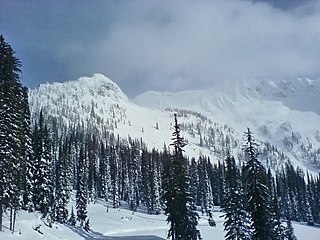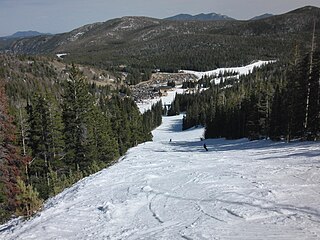Whistler Blackcomb is a ski resort located in Whistler, British Columbia, Canada. By many measures it is the largest ski resort in North America and has the greatest uphill lift capacity. It features the Peak 2 Peak Gondola for moving between Whistler and Blackcomb mountains at the top. With all of this capacity, Whistler Blackcomb is also often the busiest ski resort, often surpassing 2 million visitors a year.

A ski resort is a resort developed for skiing, snowboarding, and other winter sports. In Europe, most ski resorts are towns or villages in or adjacent to a ski area – a mountainous area with pistes and a ski lift system. In North America, it is more common for ski areas to exist well away from towns, so ski resorts usually are destination resorts, often purpose-built and self-contained, where skiing is the main activity.

An elevated passenger ropeway, or chairlift, is a type of aerial lift, which consists of a continuously circulating steel wire rope loop strung between two end terminals and usually over intermediate towers, carrying a series of chairs. They are the primary onhill transport at most ski areas, but are also found at amusement parks and various tourist attractions.

A detachable chairlift or high-speed chairlift is a type of passenger aerial lift, which, like a fixed-grip chairlift, consists of numerous chairs attached to a constantly moving wire rope that is strung between two terminals over intermediate towers. They are now commonplace at all but the smallest of ski resorts. Some are installed at tourist attractions as well as for urban transportation.

Keystone Resort is a ski resort located in Keystone, Colorado, United States. Since 1997 the resort has been owned and operated by Vail Resorts. It consists of three mountains – Dercum Mountain, North Peak, the Outback – and five Bowls offering skiing at all levels. The three mountains are connected by a series of ski lifts and gondolas and access from two base areas called River Run and Mountain House.

William Meade Lindsley Fiske III was an American combat fighter pilot and Olympic bobsledder. At the 1928 and 1932 Winter Olympics, Fiske won gold as driver for the US bobsledding team, also acting as the American Olympic flagbearer in 1932.

Aspen Mountain is a ski area in the western United States, located in Pitkin County, Colorado, just outside and above the city of Aspen. Situated on the north flank of Aspen Mountain, its summit elevation is 11,212 feet (3,417 m) above sea level. Aspen Mountain forms the end of Richmond Ridge, a long ridge that extends ten miles (16 km) south at approximately 11,000 ft (3,350 m) to join the main spine of the Elk Mountains.
The Aspen Skiing Company, known locally as Ski Co, is a commercial enterprise based in Aspen, Colorado. The Aspen Skiing Company operates the Aspen/Snowmass resort complex, comprising four ski areas: Aspen Mountain, Aspen Highlands, Buttermilk, and Snowmass.

Loveland Ski Area is a ski area in the western United States, located near the town of Georgetown, Colorado. Located at the eastern portal of the Eisenhower Tunnel, Loveland is within the Arapahoe National Forest. It is one of the closest ski areas to the Denver metropolitan area and Front Range corridor, making it popular with locals.

Banff Sunshine Village is a ski resort in western Canada, located on the Continental Divide of the Canadian Rockies within Banff National Park in Alberta and Mount Assiniboine Provincial Park in British Columbia. It is one of three major ski resorts located in the Banff National Park. Because of its location straddling the Continental Divide, Sunshine receives more snow than the neighbouring ski resorts. The Sunshine base area is located 15 km (9 mi) southwest of the town of Banff. By car, it is about a ninety-minute drive from the city of Calgary; the Sunshine exit on the Trans Canada Highway is 8 km (5 mi) west of the town of Banff.

Blue Mountain is an alpine ski resort in Ontario, Canada, 10 km west of Collingwood. It is situated on a section of the Niagara Escarpment about 1 km (0.6 mi.) from Nottawasaga Bay, and is a major destination for skiers from southern Ontario. The local area forms the newly incorporated town of The Blue Mountains, Ontario. On average, Blue Mountain sells more than 750,000 lift tickets per year, making it the third-busiest ski resort in Canada, after Whistler-Blackcomb in British Columbia and Mont Tremblant in Quebec. It is one of the largest resorts in Ontario and has been extensively built out, featuring 42 runs, 16 chairlifts and 3 freestyle terrains.

Copper Mountain is a mountain and ski resort located in Summit County, Colorado, about 75 miles (120 km) west of Denver on Interstate 70. The resort has 2,465 acres of in-bounds terrain under lease from the U.S. Forest Service, White River National Forest, Dillon Ranger District. It is operated by POWDR.

The Magic Mile is an aerial chairlift at Timberline Lodge ski area, Mount Hood, Oregon, U.S. It was named for its unique location above the tree line and for its original length. When constructed by Byron Riblet in 1938, it was the longest chairlift in existence, the second in the world to be built as a passenger chairlift, and the first to use metal towers.

Whitewater Ski Resort is a ski resort in western Canada, located a 25-minute drive from Nelson in southern British Columbia. In the Selkirk Mountains, the resort is situated in Ymir bowl, beneath the 2,400-metre-high (7,874 ft) Ymir Mountain. The Selkirks receive plentiful, dry snow, and the location in a high alpine bowl provides an annual snowfall average of approximately 12 m.

Breckenridge Ski Resort is an alpine ski resort in the western United States, in Breckenridge, Colorado. Just west of the Continental Divide in Summit County, it is perennially one of the most visited ski resorts in the western hemisphere. Breckenridge is owned and operated by Vail Resorts, Inc.

Vail Ski Resort is a ski resort in the western United States, located near the town of Vail in Eagle County, Colorado. At 5,289 acres, it is the third-largest single-mountain ski resort in the U.S., behind Big Sky and Park City, featuring seven bowls and intermediate gladed terrain in Blue Sky Basin.

Eldora Mountain Resort is a ski area in the southwest corner of Boulder County, Colorado, near the unincorporated community of Eldora and 3 miles (5 km) west of the town of Nederland.

Snow King Mountain is a summer and winter resort in the western United States, in Jackson, Wyoming. The mountain is Jackson's original 1936 ski hill, located on the southeast edge of the city, and was the first ski area in Wyoming. Locals sometimes refer to Snow King as "The Town Hill," and it offers skiing, hiking, an alpine slide, and many other attractions. The ski season runs from December to late March, and has a summer season that runs from June to October. Skiing is offered after the closure of lifts, until the snow is gone thanks to a boot pack trail on the west side of the resorts Runs. Hiking trails are offered all over the mountain.

The Hotel Jerome is located on East Main Street in Aspen, Colorado, United States. It is a brick structure built in the 1880s that is often described as one of the city's major landmarks, its "crown jewel". In 1986 it was listed on the National Register of Historic Places. It is operated by Auberge Resorts.

Sandia Peak Ski Area, originally La Madera Ski Area, is a ski resort located in the Sandia Mountains in northeast Bernalillo County, New Mexico, United States, immediately northeast of the city of Albuquerque. It is part of a Special Use Permit Zone in the Sandia Ranger District of the Cibola National Forest. It is New Mexico's first ski area, opening to skiers in 1936. It features Sandia Peak Tramway, which was until 2010 the longest tramway in the world, and remains the longest in the Americas. The resort includes 35 ski runs and a terrain park, and also serves as a site for summer recreation. It is one of the few ski resorts in the US that can be directly accessed from a major city.



















